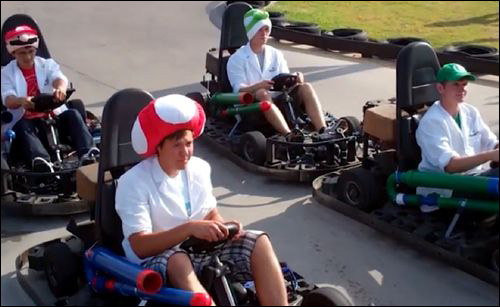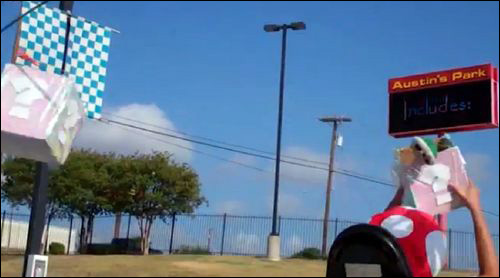For one week during the summer of 2011, a group of engineers and student interns at National Instruments played a real-world version of Nintendo‘s Mario Kart videogame. The engineers’ version featured RFID readers in modified go-karts and battery-powered RFID tags inserted into items such as stuffed toy mushrooms or a bunch of bananas that, as in the videogame, either benefited or punished participants racing toward the finish line.
The goal of the Texas group—known as Waterloo Labs—is to provide science and technology education to young people, according to Hunter Smith, Waterloo Labs’ project manager. The team of engineers does this, he says, by airing videos of its projects that they hope will trigger excitement in future entrepreneurs. Smith, an engineering specialist at National Instruments, is responsible for bringing a love of the sciences to students in grades kindergarten through 12.

The Waterloo Labs team developed the game over the course of several months within the engineers’ own homes, using primarily hardware from National Instruments, and then installed the system at Austin’s Park‘s go-kart racecourse. The deployment included four Wavetrend RX300 readers, one in each kart, as well as 10 Wavetrend TG501 personnel active 433.92 MHz tags that transmitted their unique ID number to the readers. Waterloo Labs also developed its own software system, which resides on a base-station computer at the park. The interrogators transmitted the ID numbers of the tags they read, and the software, based on that data, sent instructions to the go-kart’s electronic controls to respond to events—such as increasing the throttle in order to boost speed, or immobilizing one wheel to send the vehicle into a spin.
In June 2011, the group brought in summer interns from several colleges to develop games that could be video-recorded and displayed on YouTube. One of the three games that the interns conceived of, Smith says, was the real-life version of Mario Kart, and the team decided that RFID technology would be the best option to bring the videogame into the real word.Among the things distinguishing Mario Kart are the items that drivers can grab while on the course. Mushrooms, shells, stars and bananas trigger a variety of events that can help a participant by speeding up his or her go-kart, or slowing down competitors’ vehicles. For example, in the videogame version of Mario Kart, a player can throw a banana peel under the wheels of another player’s kart, causing that vehicle to spin out of control.
To make that action feasible in the real world, engineers needed a way of enabling the items interact with the functions of a driver’s vehicle, or with those of competitors. National Instruments had the Wavetrend readers and active tags on hand.

The group then set up the racecourse. Cardboard boxes were suspended by Velcro from an overhead wire stretched across the track, with a tagged item placed inside each box. Drivers—Waterloo’s engineers and interns—grabbed the boxes while driving beneath them, and removed the items contained within, such as a star or a bunch of bananas. The reader in the vehicle captured the ID number encoded to that item’s tag, and transmitted that information via a Wi-Fi connection to the software residing on a PC located near the course. The software then determined what should occur next, and issued instructions to the vehicle containing the reader that had captured that ID.
The software had several parameters to follow prior to triggering an event. For example, when a driver grabbed a bunch of bananas, the item’s tag ID number was read and the software then waited for the tag to be read a second time. That second read, which occurred when the driver threw the banana bunch at another kart, was carried out by that vehicle’s reader. At that time, the software instructed the affected kart’s brake system to freeze a wheel, in order to simulate the vehicle sliding on a banana peel. In another case, a star captured by a driver would trigger the software to open the throttle further on the kart, thereby allowing it to move faster down the course.To ensure that the correct tags were read and that stray tag reads did not occur as the karts passed beneath the boxed items suspended on the wire, the group had to line the boxes with aluminum foil. In that way, a tag was detected by a kart’s reader only when its item was removed from the box, after being snatched off the wire.
The YouTube video of the “Real Life Mario Kart” had been viewed approximately 75,000 times by this week, since its posting at the end of last month. Most of those views, Smith says, occurred this week, as press coverage of the system has increased. The team now hopes to design additional games that would then be aired on YouTube for young scientists.
According to Smith, Waterloo Labs is likely to employ RFID technology for future projects as well. One idea the group is currently considering is an RFID-enabled piano, similar to an instrument that appeared in the movie Big. The keyboard would be located on the floor, large enough that people could play the keys by stepping on them. Passive 13.56 MHz high-frequency (HF) tags could then be attached to the players’ shoes, with reader antennas installed in the piano’s keys. “That will require a lot of math and signal logic,” Smith says, to calculate each tag’s exact location on the keyboard.
Smith says the company believes it has met its primary goal of piquing the interest of young people by airing a video that shows how technology like RFID can be used. “We probably never will assemble [the Real-Life Mario Kart] game again,” he notes, though he hopes the video will spark interest in others. “The best-case scenario, to me, would be to spark brainstorming in someone else.”


